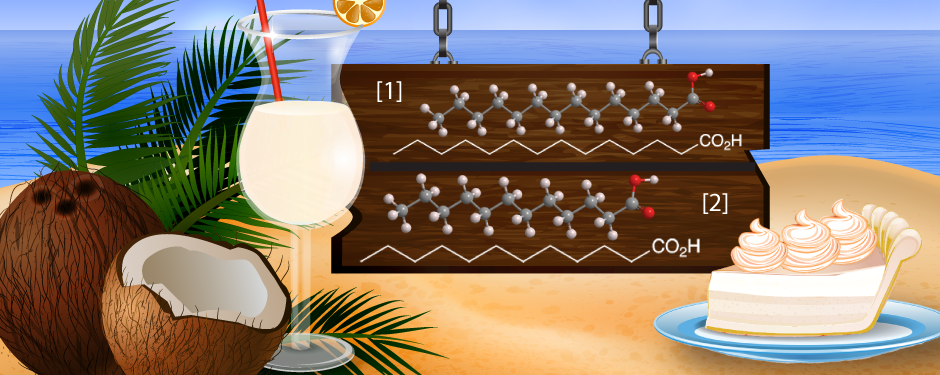What molecules are we?

Lauric acid [1] and myristic acid [2] are saturated fatty acids. Their formal names are dodecanoic acid and tetradecanoic acid, respectively. Both are white solids that are very slightly soluble in water.
Lauric acid esters (principally triglycerides) are found only in vegetable fats, primarily from coconut milk and oil, laurel oil, and palm kernel oil. In contrast, myristic acid triglycerides occur in plants and animals, notably in nutmeg butter, coconut oil, and mammalian milk.
Fatty acids have a bad name because they are strongly associated with high serum cholesterol levels in humans. Lauric and myristic acids are among the worst offenders; therefore, many governmental and health organizations advise that coconut oil and milk, among other high–saturated fat substances, should be excluded from the diet.
There is, however, a bright side for these acids. May 8 is National Coconut Cream Pie Day, perhaps the one day of the year you may wish to throw caution to the wind and eat your fill of lauric and myristic acids.
Lauric acid hazard information
| GHS classification*: serious eye damage, category 1 | |
| H318—Causes serious eye damage | |
| GHS classification: toxic to aquatic life, category 2 | |
| H401—Hazardous to the aquatic environment, acute hazard | |
*Globally Harmonized System of Classification and Labeling of Chemicals. Explanation of pictograms.
Myristic acid hazard information
| GHS classification: not a hazardous substance |
Lauric acid fast facts
| CAS Reg. No. | 143-07-7 |
| Molar mass | 200.32 g/mol |
| Empirical formula | C12H24O2 |
| Appearance | White crystals or powder |
| Melting point | 44–46 ºC |
| Water solubility | ≈1 mg/L* |
Myristic acid fast facts
| CAS Reg. No. | 544-63-8 |
| Molar mass | 228.38 g/mol |
| Empirical formula | C14H28O2 |
| Appearance | White crystals or powder |
| Melting point | 52–54 ºC |
| Water solubility | <1 mg/L* |
*Literature values vary widely.
MOTW update:
January 3, 2022
Lauric acid is a fatty acid, esters of which occur in natural substances such as coconut milk and palm kernel oil. A November 2021 market report on lauric acid states that its main use in manufacturing is as an ingredient in soaps and shampoos. Its global market size is expected to grow from US$605 million in 2020 to US$716 million by 2026.

Learn more about this molecule from CAS, the most authoritative and comprehensive source for chemical information.
Molecule of the Week needs your suggestions!
If your favorite molecule is not in our archive, please send us a message. The molecule can be notable for its current or historical importance or for any quirky reason. Thank you!
Stay Ahead of the Chemistry Curve
Learn how ACS can help you stay ahead in the world of chemistry.

